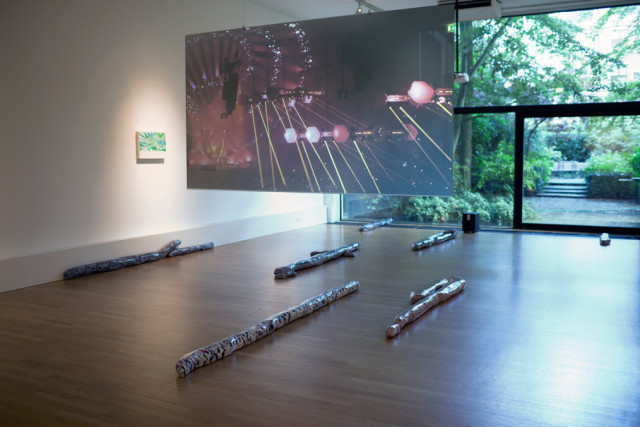A glass partition separates the exhibition space of Amsterdam’s FOAM from a plot of trees and plants outside. To all outward appearances, one side seems based on arbitrary, superficial characteristics and the other on natural, organic relationships. But the transparency of this otherwise hard disconnection is, on a macro level, symbolic of a merger made apparent through micro level affairs inside Anne de Vries‘ E _ M E R G E, running August 28 to November 1, itself.
Often appearing as organic forms from afar, on closer inspection the work of the Berlin-based Dutch artist offers insight into underlying technological agency in the digital era and, more specifically, how it relates to the human desire for progress. Photographic images of shavers and sneakers, which, like vine growth forms of plants colonising a house, ascend draped over manufactured frames and structures. Enveloped within is the representation of human masses — pictures of immanent uprisings that show more explicitly a natural yearning to advance, or crowds of people in search of enlightenment rendered through the photographic lens. ‘Critical Mass : Pure Immanence’ (2015) and ‘Boids’ (2015), both displayed at the entrance to E _ M E R G E are representative of those concerns that continue to resonate throughout the exhibition.

The show is a comprehensive presentation of De Vries’ work, and comprises both new and already existing pieces. While broad in this sense, it’s tapered toward specific issues — in particular, those engendered by the ‘natural’ existence and formation of bodies like the internet, Photoshop, Tumblr, and mobile upload feeds. As a result, De Vries’ language is informed by agencies that perpetually infiltrate those bodies like corporate branding, commercial merchandising, and stock photography. The same images that cling organically to E _ M E R G E are also reminiscent of the language of corporate advertising campaigns.
Of particular interest is the way new technologies are grounded in a human desire for progress, i.e., to expand human capacity and overcome physical and mental limitations — according to De Vries: “an ancient quest in which science, art and the spiritual are bound up together, a quest that has produced the manipulated reality of our day and of the future”. This is portrayed in works like ‘Katanga Bub’, (2011) ‘Steps of Recursion on rail — ICG’ (2012) and two ‘Image Transfers’ (2012). As Katja Novitskova effectively describes in her ‘The Merging of Matter and Information‘, “works by Anne de Vries offer access to our increasing entanglement with technology — its material and symbolic origins, our sense of the world as part of the universe and our expanding understanding of the laws of physics through different media”. It brings into question commodities as living things and, at the same time, art in terms of ecological laws.

‘Katanga Bub’ depicts the landscape and workers of Katanga, in the Democratic Republic of Congo, through a distorted press image of its mines rephotographed underwater, while various mobile phones planted against the image provide a ‘clearer’ picture. ‘Steps of Recursion on rail — ICG,’ on the other hand, is a sculpture comprised of a digital print of a sneaker connected to a steel frame. The transition of the recurring footwear between two points is reflective of an upward moving conception of progress, while also referencing that fact that they themselves are “often branded to embody the spirit to strive further to improve oneself”. **













